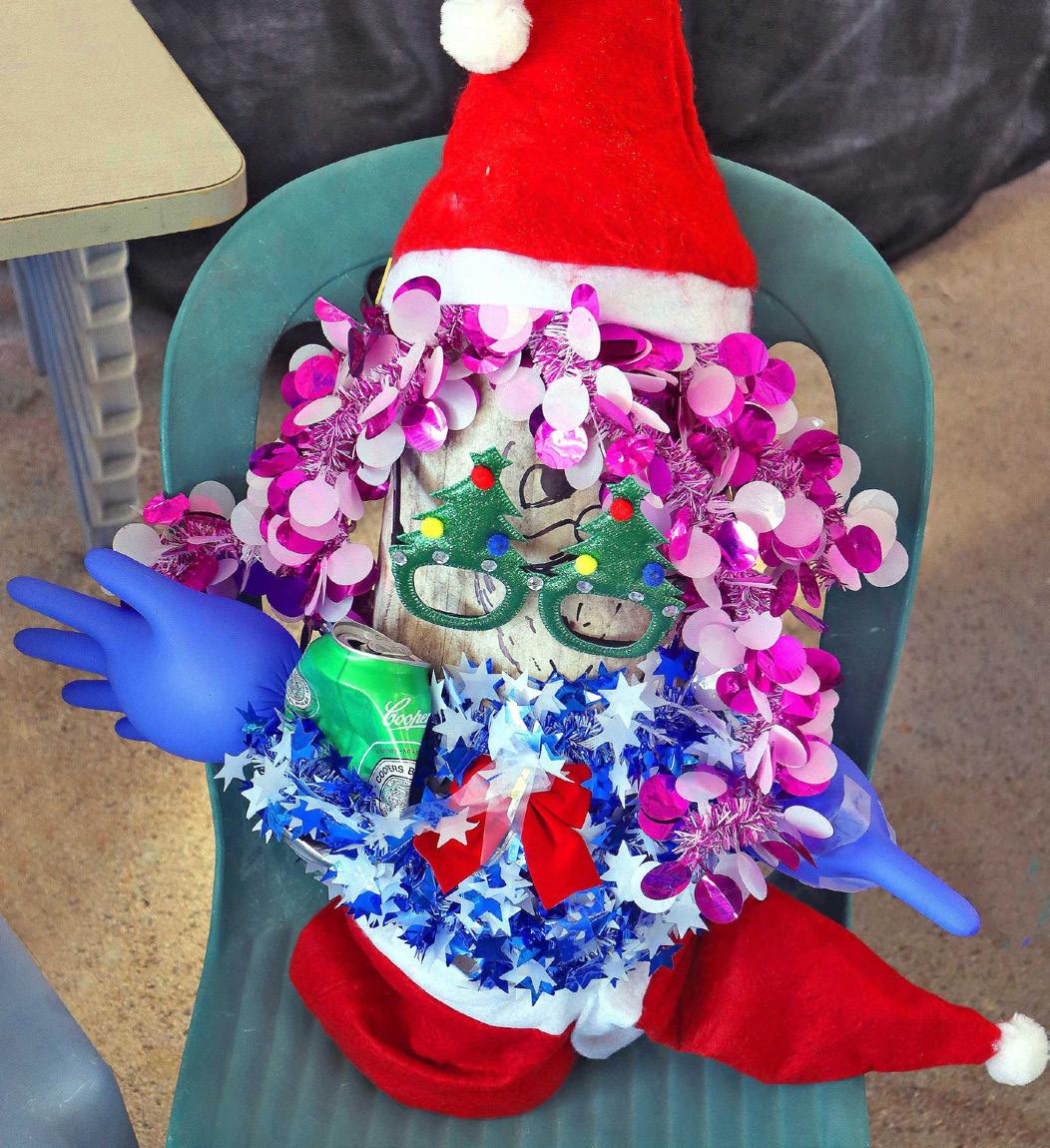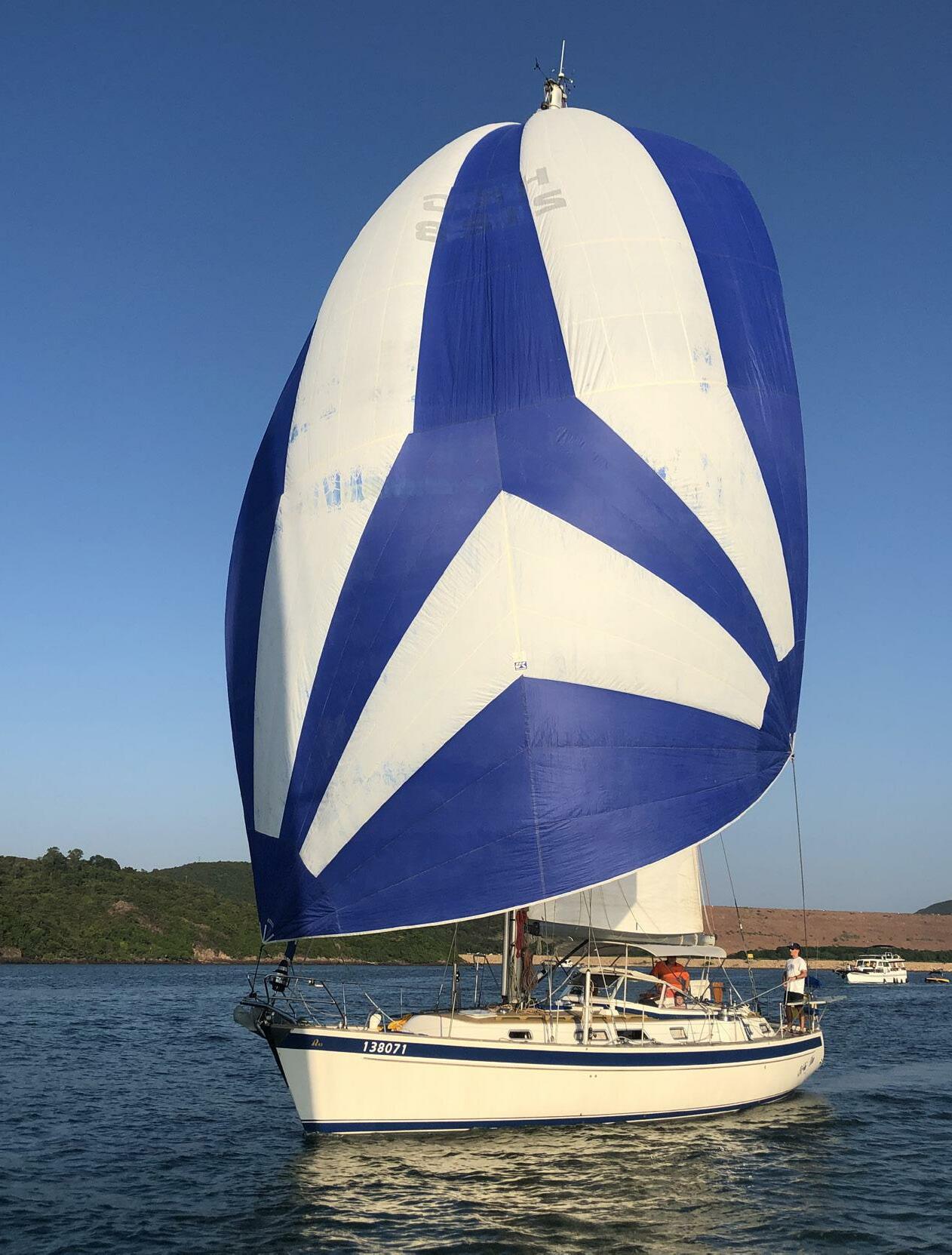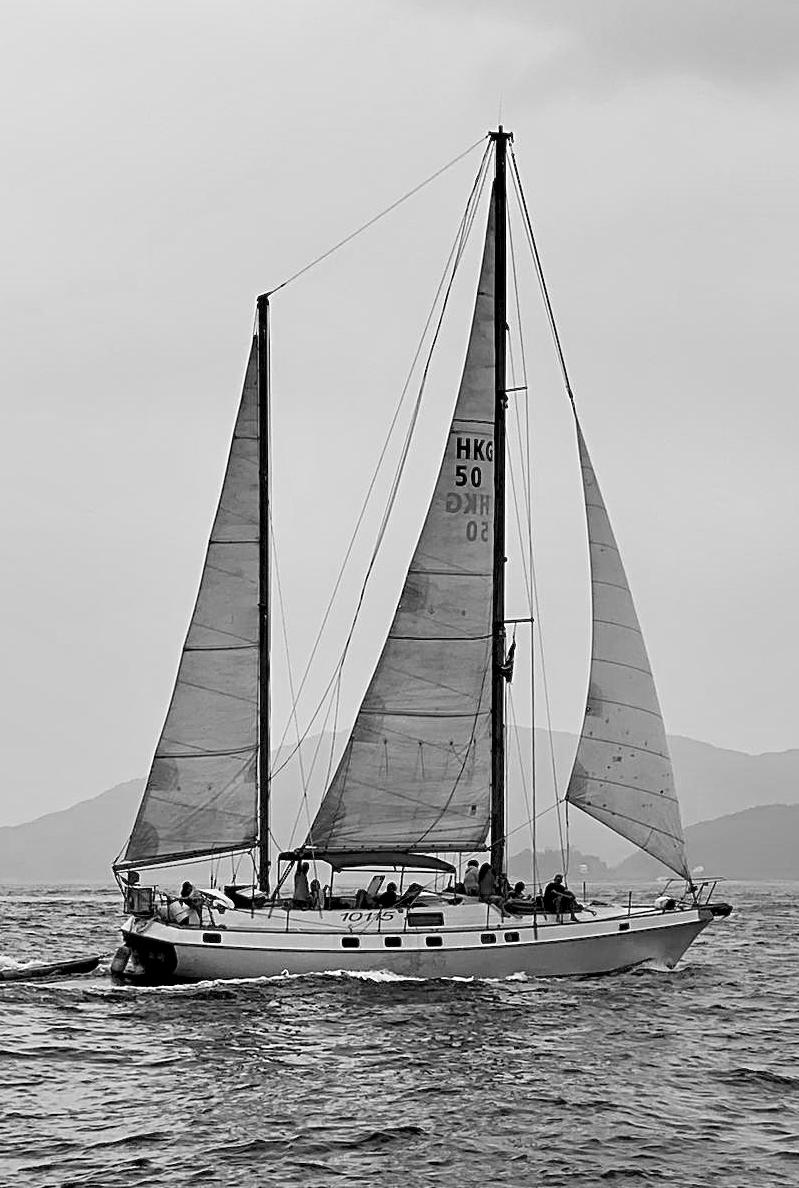
10 minute read
BOXING DAY ADVENTURE
If you were looking for snow then there was no need to venture to the US or UK for the extreme conditions experienced there on Boxing Day the 26 December 2022. Instead, all you needed to do was sign-up for the Hebe Haven Yacht Club’ s Boxing Day Fun Cruise & Treasure Hunt 2022.
Conditions were glorious with blue skies and an 8- to 10-knot easterly when the boats headed out from Hebe Haven into Port Shelter in their own time for what is intended as a fun cruise and treasure hunt, organised in conjunction with the Cruising Sailors of Hebe.
Advertisement
Given the co-ordinates of the first mark, off Trio Beach, there they found a letter of a four letter word, together with the co-ordinates of the next mark off the northwest shore of Shelter Island. There they would find another letter and coordinates to the third mark and another letter near Cascade Bay. From that point they were directed to the fourth mark, through choppy seas off the bottom of Jinn Island, to the last mark – and final letter – north of Bay Islet.
It was then into a finish line at the entrance to Leung Shuen Wan, before anchoring and heading ashore for a long lunch and prize-giving at High Island (Yau Ley) Seafood Restaurant. Fortunately, or unfortunately, no one actually found SNOW as the letter ‘N’ had gone missing from the second mark off Shelter Island!
The instructions indicated that the finish would be between 1230 and 1300 at High Island, however, given the conditions, five of the official eight entries, or nine if you include Sarah, which tagged along for fun, arrived before 1230 and could not resist the temptation of seafood and drinks, so recorded a DNF. First of these was Jannati, 2nd Wooligan, 3rd Baring Asia 2, 4th Dragonfly and 5th Happy King
With the blue flag hoisted on Hebe One, the race officer, Chris Howarth, opened the finish line at 1230 with his assistant, Arick Chan, recording the catamaran Abiders, which appeared to have sailed all the way, with line honours at 1240. The J/80, Jelik 6, also sailed across the line in 2nd place with Sousa Moi 3rd, followed by the unregistered Sarah
Meanwhile, the guests on Hebe One, who joined the cruise, were dispatched to the restaurant.
Once ashore the crews and guests tucked into the delicious seafood, washed down with various libations.
In addition to the award for first boat across the finish line, five other awards were made. The first was for best result in the 20-question quiz. Hebe One and Jannita tied on 12 points with the tie breaker in favour of Hebe One. The next award was for re-writing a Christmas carol and singing it before the presentations. Happy King came 4th while Sousa Moi ’s version of ‘Rudolf the Red-Nosed Reindeer’ was adapted to suit Kismet—the dog who joined in with the choralists. Again, it was close between Dragonfly which took the prize despite Jannita’s wonderful version of ‘The 12 Days of Christmas’ adapted to ‘The 12 days of Covid-19’. Fortunately, they stopped after the sixth day.
Ensuring the awards were fairly distributed amongst the participants, Happy King received the award for Best Dressed Boat while Jannita received the Best Dressed Crew award.
The final award was for Best Dressed Fender in the Festive Theme. The three entries were from Jannita, Dragonfly and Sousa Moi, the last two both highly commended, with Sousa Moi ’s ‘Offending Fender’ claiming the honours.

With the awards and lunch over, the crews re-embarked on their vessels with some reconvening back at Hebe for further libations, where two committee members agreed it was a wonderful day on the water particularly in promoting good fellowship and club spirit.
在懸掛了藍旗的 Hebe One 上,賽事主任 Chris
Howarth 於 12:30 與助
手 Arick Chan 一同展 開終點綫,記錄了似乎 一直在航行的雙體船 Abiders 在12時40分獲 得殊榮。J/80 帆船 Jelik 6 以第二名的姿態衝過 終點,Sousa Moi 緊其 後成為第三名,然後是 未有報名的 Sarah。
另外,乘坐 Hebe One 參加巡航的貴賓也被帶 餐廳用餐。
上岸後,船員和賓客就 能一同品嚐美味海鮮, 並享用各種酒類。 除頒奬予第一艘穿過終 點線的船隻外,本會還 頒發了另外五個獎項。
則非常切合加入了合唱團的小狗 Kismet。儘管 Jannita 把《The 12 Days of Christmas( 聖誕節 12 天)》改篇為《The 12 days of Covid-19》可謂神來之筆,但 Dragonfly 仍以 輕微差距取得大獎。可幸的是,他們在第六日後便停下了。 為確保獎項能公平分配予參賽者,Happy King 獲得了最佳船隻裝飾大獎,而 Jannita 則 獲得最佳船員穿著大獎。
by Stu Pryke
Red Tide
Slipping moorings a few weeks ago for a precious excursion into 18 knots of a South Easter abeam Shelter Island, I couldn't help but marvel over how clean the inner waterway of Hebe Haven had become. Indeed, the water visibility was beyond two metres and with mullet breaching on a regular basis, our water's health could not appear to be better.
Turning a soft left at the 193 light and what was a clean wake, rapidly became a brown and turbid mess. The bow refused to produce its normally clear breaking primary wave and instead, cut into a chocolate coloured mass of turgidity. Welcome to a Hong Kong red tide. Throttling back in an effort to avoid the thicker mass of this watery red cumulus, I was hit by the odour of what could only be a combination of rotting fish and nullah overflow. Yes, it was putrid to say the least.
So, what actually is this phenomena, this Red Tide? In essence, (no pun intended), it is a natural occurring event triggered by a massive bloom of densely concentrated algae and a variety of plankton species. There is debate over how much of this tide is owed to human interventions, such as poor land water runoff management, nitrates and sewerage spills, but one thing is key: water salinity, oxygen levels and positions of the thermocline all contribute to potential and massive fish die offs. Whilst a red tide may start as a nontoxic event, it can rapidly, and within hours, become a super toxic soup. Swim—I think not, and certainly if you have a wet labrador, keep the hound dry until the tide is reduced to better turbidity or has disappeared entirely. This process may take a few days but what is often left is a body of water devoid of live fish, including airborne mullet and a substantial foamy rust coloured tide line.
Hong Kong experiences an average of 14 Red Tide events each year and normally these occur in spring, as the colder thermoclines rise towards the surface. Current behaviour, global warming and variations in the great ocean gyres will all contribute to what we see as localised red tide formations, so it’s not all about locality per se. Typically and before the Stonecutters sewerage project took effect, human waste mixed with landfill by product catalysed the effects of red tides such that fish die offs and subsequent decomposition, sucked the very oxygen heart out of the water, bad for filter feeding marine animals, (bivalves etc.) and our fish farms. A trip to Yau Ley for scallops and chilli prawns may prudently be delayed until a red tide has substantially cleared.
So, if these tidal blooms occur in spring, why then are we seeing this happen in November? Global warming? Landfill dumping at sea. And as to who is doing this—a clue here is to take a look at the labelling of the trash often seen on the surface of a red tide. It may surprise you! Or simply a variation in the biocycles of algae growth in the South China Sea?
Nothing is really hard and fast from the perspective of sound science with red tides but one thing is certain. They are here to stay and have become less predictable in our spring calendar.
If, like me, you end up in the kernel of a thick, red tide, then it’s suggested, you throttle back to reduce the through flow over your filters but then once in clearer waters, increase the revs to purge. That’s always good for the injectors and the heat exchanger and may even dislodge trash and decomposed material from the seacock inlets. But don't ask me to get wet to check them.
片朱古力色的洶湧浪潮之中。歡迎體驗香港的紅潮。爲了 避開這片紅色的浮積物,我減慢了速度,鼻子傳來腐爛的 魚腥味和溝渠溢出的惡臭。是的,實在非常難聞。 所以,到底紅潮是甚麼現象?從本質來說,這是一個由 大量密集繁殖的藻類和各種浮游生物引發的自然現象。 對於紅潮的成因有多少是屬於人爲干預,例如土溢出地 徑流管理不善、硝酸鹽和污水,一直存在爭議。但關鍵 的一點是水的鹽度、氧氣水平和溫躍層的位置都會造成 潛在和大規模魚類死亡。雖然紅潮起始之時可能是無毒 的事件,但它會在數小時內迅速演變成充滿劇毒的湯一 樣。游泳。我建議不要,而如果您有一隻濕的拉布拉多 犬,盡量讓牠保持乾爽直至紅潮的混濁度減輕或完全消 失。這或需時數天,但一般不剩任何活魚,包括跳躍的 鯔魚,水域只留下大量泡沫狀的鐵鏽色潮汐線。 香港平均每年經歷 14 次紅潮,通常發生在春季,因為 較冷的溫躍層上升至水面。水流的活動、全球暖化和大 洋環流的變化都會引致我們所見的局部紅潮形成,因此 這不只與本地的因素有關。一般來說,在昂船洲污水渠 計劃實施之前,人類產生的廢物會與垃圾堆填區的副產 品混合,催化了紅潮的影響,導致魚類死亡及隨後的分 解,抽走了水中的氧氣,對濾食海洋動物(雙殼類等)
Reference for chart plotting must be in the first instance to the updated Admiralty paper charts 3489 and larger. eSeaGo and Navionics via MFD chart plotters etc. (On my boat, I use B and G equipment and all its macro capability is good for this passage. I understand that Raymarine and Garmin are as good, if not better).
Food and Beverage
The Club will endeavour to provide ship's stores and food takeaways for all boats for self-pick up. Beer and water, stored under cabin sole floor boards make for ideal buoyancy and easy access if access to fridges and lockers might become difficult. I use old 5 litre water containers to reuse and store under the galley sole.

by Stu Pryke
存在船艙底地板下的啤酒和水,在難以使用冰箱和儲物櫃 時,提供理想的浮力之餘又方便取用。(我重複使用舊的 5 公升容器,並將其存放於廚房底部。)
即使短期航行亦需注意航員道德。一段恰當的的航員簡報、即 使是一個安全設備的位置的在簡介,以及一個乾糧零食盒,亦 是能讓您的航員承認您的領導地位,並安靜地回顧他們在船上 擔當的職務。爲過夜的航員分配獨立的儲物櫃和牀鋪同樣是關 鍵。取得航員家人的電話號碼,並記錄於日誌之中。
確保水箱和燃料足以行駛 41 海哩以及額外 30% 的應急額 度。(這並非一場賽事,船隻的環繞賽表現對行駛航道並不重 要) 現在就是檢查引擎效能詳情的好時機;在基本的 70% 動 力設定下的燃料流量會是多少?(Yanmar 非渦輪 100hp 發動 機在 70% 設定運行時速度約為每小時 2.5 升。) 以量油尺檢 查燃油位,並由後方發動機加油點檢查變速箱油位。檢查交
Even a short passage needs attention to crew moral. A proper crew brief, location of safety equipment, even if it’s a review and a snack box with dry stores, will be good agency for your crew to acknowledge your leadership and quietly review their own roles aboard. Allocation of individual locker stowage and bunk space for those overnighting is also key. Take phone numbers for crew's shore based family and inscribe in the logbook.
Ensure water tanks and fuel will be sufficient for a 41 nm passage plus contingency of 30%. (This is NOT a race and sailing performance for round the can racing, is not core to passage sailing). Now will be a good time to check with your engine performance details; what fuel flows will be at a nominal 70% power setting? (A Yanmar non turbo 100hp engine at 70% runs at about 2.5 Litres/hr.) Check oil levels via the dip stick and gear box oil via the aft engine access filler point. Alternator belts and coolant check for tightness and quantity.

Passage Planning
Passage planning, unlike racing per se, requires identifying trends. The usual rig checks for split pin integrity, wire locks, shackle shape, running rigging etc., goes without saying. This includes your familiarity in reefing your mainsail. Slab reefing systems need practice and if you are rusty in this area, then take the boat out to practice putting ALL three reefs into your main. Furling systems are straight forward generally but the decision to reef needs early intervention and a thorough briefing with your crew. If there is doubt then there is no doubt. If on the day, predictions are F4 to F5 (11 to 16, 17 to 21 knots), your sail plan will be close to a first reef requirement. Late shortening of sail can prove problematic, especially with crew who are not used to reefing in strong wind and wave conditions.

A good tip given by an old salt: clean your engine bay. A clean engine floor will show up a wealth of trends. Oil leaks, belt wear, water ingress and even engine parts shedding, such as alternator tightening bolts and jubilee clips. If you are planning to anchor then check your windlass for efficacy; chain out and returned, together with condition of the anchor swivel, chain and additional scope. Will your batteries be good for navigational lights, anchor light and morning engine start? You might need an anchor snubber and anchor ball. Check what sort of ground your anchor prefers; a Rocna will be good on most holdings but a Danforth poor on sand. What water terrain will you expect at Lamma Power station bay or Middle Island?
Ensure you are happy with passage navigation protocols. Navigation table clear of non-navigation material. Log book accessible. Will you plot your position on passage every hour? Watch system? AIS alerts and Man Overboard protocols, (MOB; check you are familiar with this by marking a MOB event on your Chart plotter).
Safety
Safety begins before the engine start. A thorough crew briefing with location of safety equipment, via a post brief questioning should ensure rapid access to safety gear when needed. This will include location of MOB equipment, manual bilge pumps, first aid box, safety harnesses and jack lines. VHF dual watch on channels 96 and 16. Check who in your crew is happy with radio usage and signal check your radio prior to slipping moorings. Mobile phone systems will eventually fall from range but coastal coverage for emergency services may be accessible. In HK waters, CH 16 is often used as a chat channel, so attention getting in an emergency MUST be accompanied with a PAN or a MAYDAY as required by the event.
If your galley is gas powered then ensure ALL crew know how to use the gas system. After use protocols and location of firefighting equipment, Carbon Monoxide detectors and gas leak systems.
If your yacht carries a life raft, then check its service dates and that its maximum capacity is not exceed by your crew compliment. Allow the crew to assess its use, its release and best point to board should it be needed.
In sea swells over two metres and F5 and above, mandate the use of personal life jackets, MOB devices and safety harnesses if working outside the cockpit
This is a good opportunity to check your spares locker for essentials. belts, impellers, jubilee clips, shackles, engine oil and filters and ensure the crew know location of essential tools and gear. (I have a ship's plan sketched to show safety gear location, sea cocks, and quick access equipment).
Most passage vessels with mixed crews will have a set of Standard Operating Procedure, (SOP's). These will include what you as Skipper expect from your crew and will be a reference, (admittedly for longer passages than under 50 nm) for them and additional to your briefing. It may include use of alcohol when under way, smoking and vaping, use of mobile phones when under way, watch keeping measures etc).
Safety briefings are not exclusive and as Skipper you have to assume that the knowledge base of your crew should be at least equivalent to a RYA competent crew certificate. The briefing should never be rushed and allow time at the end for both questioning and discussion. This will allow you to place measure to your crew both in understanding their abilities and how you appoint a watch buddy system. To complete the briefing and to re affirm the overall system that your crew will work with, i.e., your boat as a total dynamic, then take them through the boat, above and below decks; this will be the last "soft" review they will have before you make way.
Remember, as some wag stated. "A bad day sailing is 100 times better than a good day at work"
Clean bilge, safe sailing and a smooth wake to all.










